NVIDIA's GeForce GTX 580: Fermi Refined
by Ryan Smith on November 9, 2010 9:00 AM ESTPower, Temperature, and Noise
Last but not least as always is our look at the power consumption, temperatures, and acoustics of the GTX 580. NVIDIA’s performance improvements were half of the GTX 580 story, and this is the other half.
Starting quickly with voltage, as we only have one card we can’t draw too much from what we know, but there are still some important nuggets. NVIDIA is still using multiple VIDs, so your mileage may vary. What’s clear from the start though is that NVIDIA’s operating voltages compared to the GTX 480 are higher for both idle and load. This is the biggest hint that leakage has been seriously dealt with, as low voltages are a common step to combat leakage. Even with these higher voltages running on a chip similar to GF100, overall power usage is still going to be lower. And on that note, while the voltages have changed the idle clocks have not; idle remains at 50.6MHz for the core.
| GeForce GTX 480/580 Voltages | |||||
| Ref 480 Load | Ref 480 Idle | Ref 580 Load | Ref 580 Idle | ||
| 0.959v | 0.875v | 1.037v | 0.962v | ||
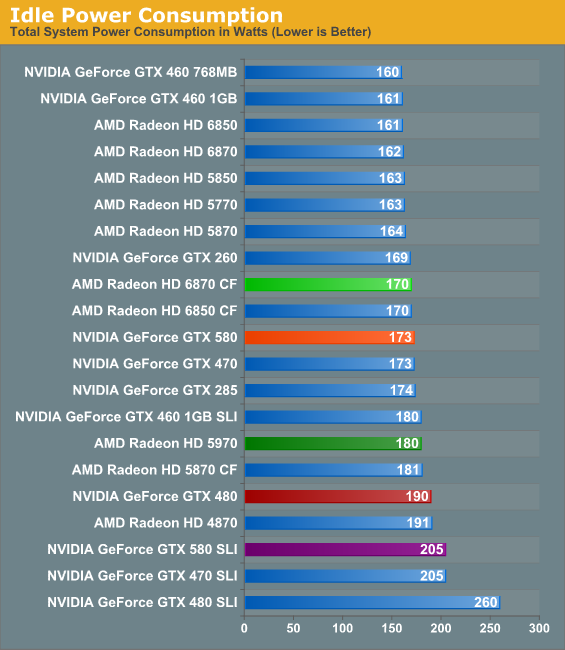
Beginning with idle power, we’re seeing our second biggest sign that NVIDIA has been tweaking things specifically to combat leakage. Idle power consumption has dropped by 17W on our test system even though the idle clocks are the same and the idle voltage higher. NVIDIA doesn’t provide an idle power specification, but based on neighboring cards idle power consumption can’t be far off from 30-35W. Amusingly it still ends up being more than the 6870 CF however, thanks to the combination of AMD’s smaller GPUs and ULPS power saving mode for the slave GPU.
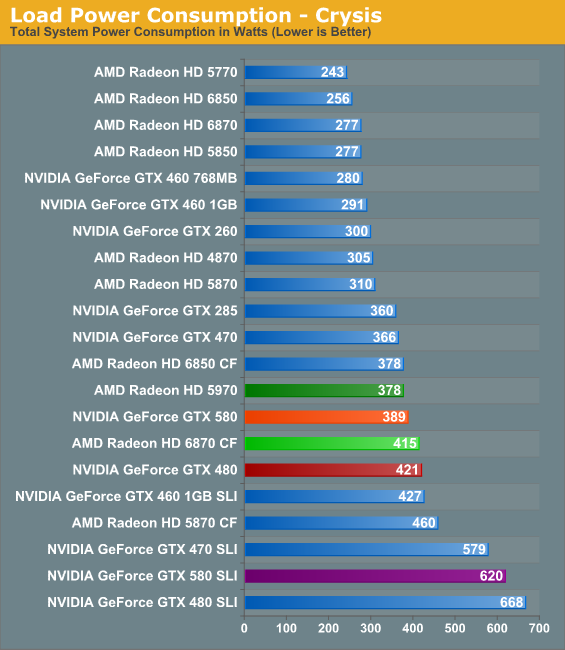
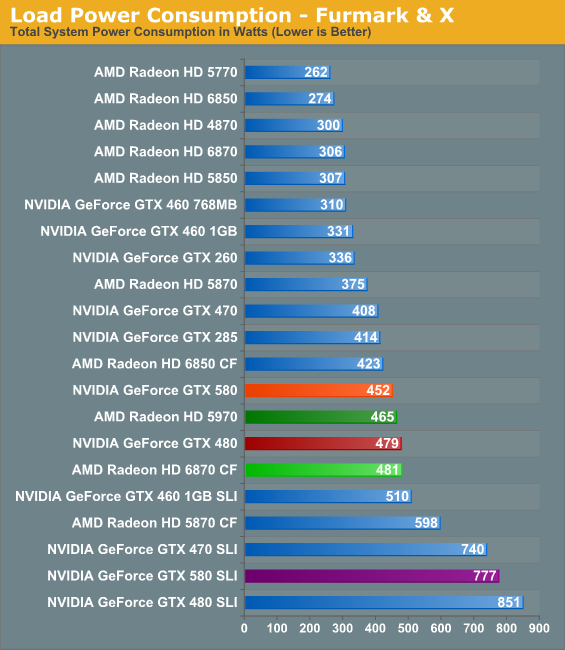
Looking at Crysis, we begin to see the full advantage of NVIDIA’s optimizations and where a single GPU is more advantageous over multiple GPUs. Compared to the GTX 480 NVIDIA’s power consumption is down 10% (never mind the 15% performance improvement), and power consumption comes in under all similar multi-GPU configurations. Interestingly the 5970 still draws less power here, a reminder that we’re still looking at cards near the peak of the PCIe specifications.
As for FurMark, due to NVIDIA’s power throttling we’ve had to get a bit creative. FurMark is throttled to the point where the GTX 580 registers 360W, thanks to a roughly 40% reduction in performance under FurMark. As a result for the GTX 580 we’ve swapped out FurMark for another program that generates a comparable load, Program X. At this point we’re going to decline to name the program, as should NVIDIA throttle it we may be hard pressed to determine if and when this happened.
In any case, under FurMark & X we can see that once again NVIDIA’s power consumption has dropped versus the GTX 480, this time by 27W or around 6%. NVIDIA’s worst case scenario has notably improved, and in the process the GTX 580 is back under the Radeon HD 5970 in terms of power consumption. Thus it goes without saying that while NVIDIA has definitely improved power consumption, the GTX 580 is still a large, power hungry GPU.
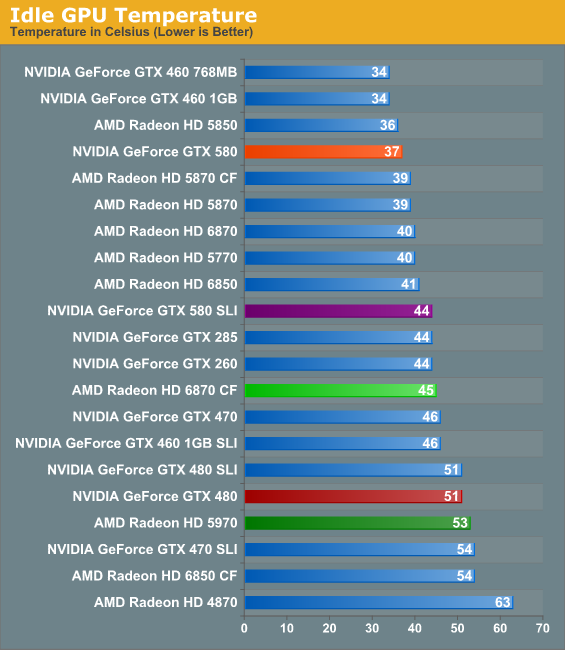
With NVIDIA’s improvements in cooling and in idle power consumption, there’s not a result more dramatic than idle GPU temperatures. The GTX 580 isn’t just cooler, it’s cool period. 37C is one of the best results out of any of our midrange and high-end GPUs, and is a massive departure from the GTX 480 which was at least warm all the time. As we’ll see however, this kind of an idle temperature does come with a small price.
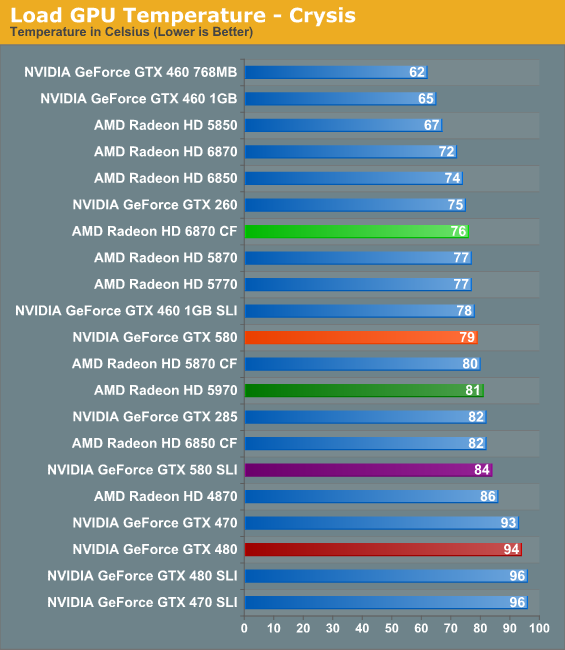
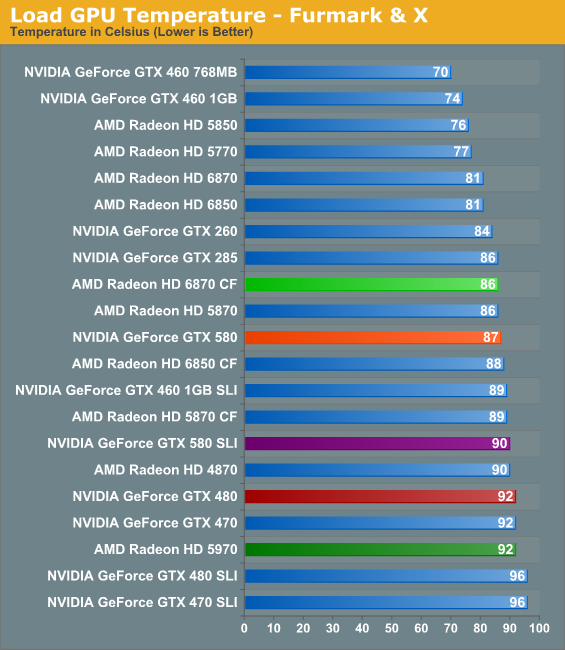
The story under load is much the same as idle: compared to the GTX 480 the GTX 580’s temperatures have dramatically dropped. At 79C it’s in the middle of the pack, beating a number of single and multi GPU setups, and really only losing to mainstream-class GPUs and the 6870 CF. While we’ve always worried about the GTX 480 at its load temperatures, the GTX 580 leaves us with no such concerns.
Meanwhile under FurMark and Program X, the gap has closed, though the GTX 580 remains in the middle of the pack. 87C is certainly toasty, but it’s still well below the thermal threshold and below the point where we’d be worried about it. Interestingly however, the GTX 580 is actually just a bit closer to its thermal threshold than the GTX 480 is; NVIDIA rated the 480 for 105C, while the 580 is rated for 97C. We’d like to say this vindicates our concerns about the GTX 480’s temperatures, but it’s more likely that this is a result of the transistors NVIDIA is using.
It’s also worth noting that NVIDIA seems to have done away with the delayed fan ramp-up found on the GTX 480. The fan ramping on the GTX 580 is as near as we can tell much more traditional, with the fan immediately ramping up with higher temperatures. For the purposes of our tests, this keeps the temperatures from spiking as badly.
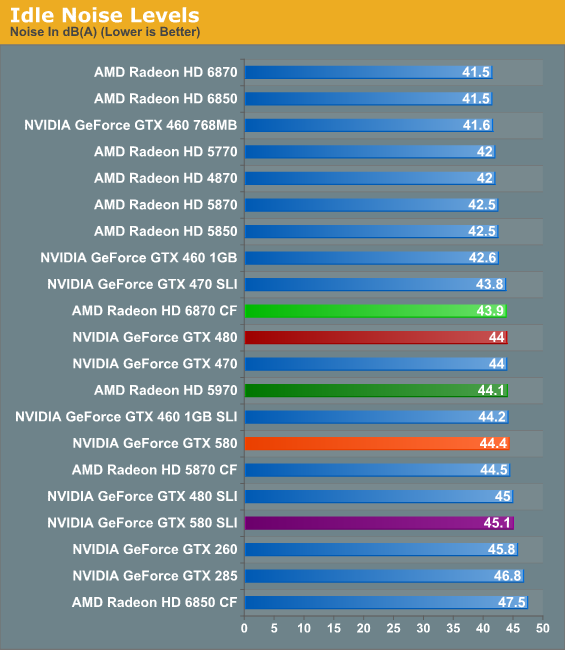
Remember where we said there was a small price to pay for such low idle temperatures? This is it. At 44.4dB, the 580 is ever so slightly (and we do mean slightly) louder than the GTX 480; it also ends up being a bit louder than the 5970 or 6870CF. 44.4 is not by any means loud, but if you want a card that’s whisper silent at idle, the GTX 580 isn’t going to be able to deliver.
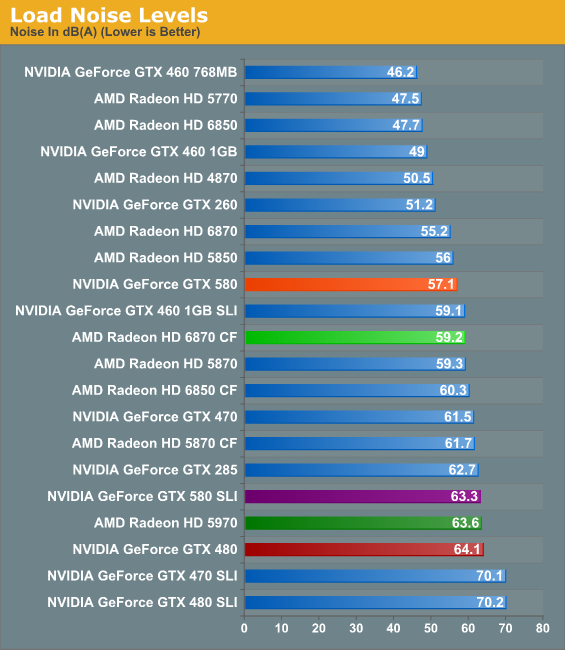
And last but not least is load noise. Between their improvements to power consumption and to cooling, NVIDIA put a lot of effort in to the amount of noise the GTX 580 generates. Where the GTX 480 set new records for a single GPU card, the GTX 580 is quieter than the GTX 285, the GTX 470, and even the Radeon HD 5870. In fact it’s only a dB off of the 5850, a card under most circumstances we’d call the epitome of balance between performance and noise. Graphs alone cannot demonstrate just how much of a difference there is between the GTX 480 and GTX 580 – the GTX 580 is not whisper quiet, but at no point in our testing did it ever get “loud”. It’s a truly remarkable difference; albeit one that comes at the price of pointing out just how lousy the GTX 480 was.
Often the mark of a good card is a balance between power, temperature, and noise, and NVIDIA seems to have finally found their mark. As the GTX 580 is a high end card the power consumption is still high, but it’s no longer the abnormality that was the GTX 480. Meanwhile GPU temperatures have left our self-proclaimed danger zone, and yet at the same time the GTX 580 has become a much quieter card under load than the GTX 480. If you had asked us in what NVIDIA needed to work on with the GTX 480, we would have said noise, temperature, and power consumption in that order; the GTX 580 delivers on just what we would have wanted.










160 Comments
View All Comments
RussianSensation - Wednesday, November 10, 2010 - link
Very good point techcurious. Which is why the comment in the review about having GTX580 not being a quiet card at load is somewhat misleading. I have lowered my GTX470 from 40% idle fan speed to 32% fan speed and my idle temperatures only went up from 38*C to 41*C. At 32% fan speed I can not hear the car at all over other case fans and Scythe S-Flex F cpu fan. You could do the same with almost any videocard.Also, as far as FurMark goes, the test does test all GPUs beyond their TDPs. TDP is typically not the most power the chip could ever draw, such as by a power virus like FurMark, but rather the maximum power that it would draw when running real applications. Since HD58/68xx series already have software and hardware PowerPlay enabled which throttles their cards under power viruses like FurMark it was already meaningless to use FurMark for "maximum" power consumption figures. Besides the point, FurMark is just a theoretical application. AMD and NV implement throttling to prevent VRM/MOSFET failures. This protects their customers.
While FurMark can be great for stability/overclock testing, the power consumption tests from it are completely meaningless since it is not something you can achieve in any videogame (can a videogame utilize all GPU resources to 100%? Of course not since there are alwasy bottlenecks in GPU architectures).
techcurious - Wednesday, November 10, 2010 - link
How cool would it be if nVidia added to it's control panel a tab for dynamic fan speed control based on 3 user selectable settings.1) Quiet... which would spin the fan at the lowest speed while staying just enough below the GPU temperature treshold at load and somewhere in the area of low 50 C temp in idle.
2) Balanced.. which would be a balance between moderate fan speed (and noise levels) resulting in slightly lower load temperatures and perhaps 45 C temp in idle.
3) Cool.. which would spin the fan the fastest, be the loudest setting but also the coolest. Keeping load temperatures well below the maximum treshold and idle temps below 40 C. This setting would please those who want to extend the life of their graphics card as much as possible and do not care about noise levels, and may anyway have other fans in their PC that is louder anyway!
Maybe Ryan or someone else from Anandtech (who would obviously have much more pull and credibility than me) could suggest such a feature to nVidia and AMD too :o)
BlazeEVGA - Wednesday, November 10, 2010 - link
Here's what I dig about you guys at AnandTech, not only are your reviews very nicely presented but you keep it relevant for us GTX 285 owners and other more legacy bound interested parties - most other sites fail to provide this level of complete comparison. Much appreciated. You charts are fanatastic, your analysis and commentary is nicely balanced and attention to detail is most excellent - this all makes for a more simplified evaluation by the potential end user of this card.Keep up the great work...don't know what we'd do without you...
Robaczek - Thursday, November 11, 2010 - link
I really liked the article but would like to see some comparison with nVidia GTX295..massey - Wednesday, November 24, 2010 - link
Do what I did. Lookup their article on the 295, and compare the benchmarks there to the ones here.Here's the link:
http://www.anandtech.com/show/2708
Seems like Crysis runs 20% faster at max res and AA. Is a 20% speed up worth $500? Maybe. Depends on how anal you are about performance.
lakedude - Friday, November 12, 2010 - link
Someone needs to edit this review! The acronym "AMD" is used several places when it is clear "ATI" was intended.For example:
"At the same time, at least the GTX 580 is faster than the GTX 480 versus AMD’s 6800/5800 series"
lakedude - Friday, November 12, 2010 - link
Never mind, looks like I'm behind the times...Nate007 - Saturday, November 13, 2010 - link
In the end we ( the gamers) who purchase these cards NEED to be be supporting BOTH sides so the AMD and Nvidia can both manage to stay profitable.Its not a question of who Pawns who but more importantly that we have CHOICE !!
Maybe some of the people here ( or MOST) are not old enough to remember the days when mighty
" INTEL" ruled the landscape. I can tell you for 100% fact that CPU's were expensive and there was no choice in the matter.
We can agree to disagree but in the END, we need AMD and we need NVIDIA to keep pushing the limits and offering buyers a CHOICE.
God help us if we ever lose one or the other, then we won't be here reading reviews and or jousting back and forth on who has the biggest stick. We will all be crying and complaining how expense it will be to buy a decent Video card.
Here's to both Company's ..............Long live NVIDIA & AMD !
Philip46 - Wednesday, November 17, 2010 - link
Finally, at the high end Nvidia delivers a much cooler and quiter, one GPU card, that is much more like the GTX 460, and less like the 480, in terms of performance/heat balance.I'm one where i need Physx in my games, and until now, i had to go with a SLI 460 setup for one pc and for a lower rig, a 2GB 460 GTX(for maxing GTA:IV out).
Also, i just prefer the crisp Nvidia desktop quality, and it's drivers are more stable. (and ATI's CCC is a nightmare)
For those who want everything, and who use Physx, the 580 and it's upcoming 570/560 will be the only way to go.
For those who live by framerate only, then you may want to see what the next ATI lineup will deliver for it's single GPU setup.
But whatever you choose, this is a GREAT thing for the industry..and the gamer, as Nvidia delivered this time with not just performance, but also lower temps/noise levels, as well.
This is what the 480, should have been, but thankfully they fixed it.
swing848 - Wednesday, November 24, 2010 - link
Again, Anand is all over the place with different video cards, making judgements difficult.He even threw in a GTS 450 and an HD 4870 here and there. Sometimes he would include the HD 5970 and often not.
Come on Anand, be consistent with the charts.